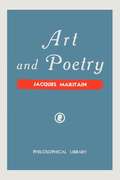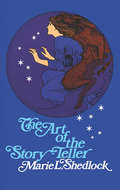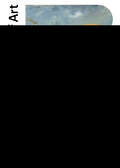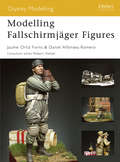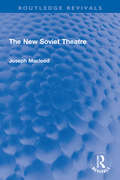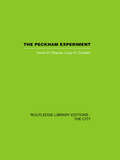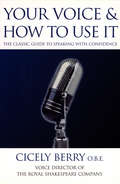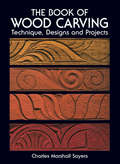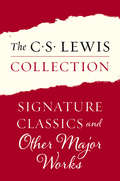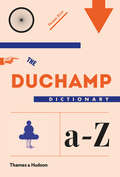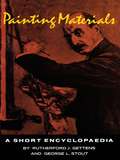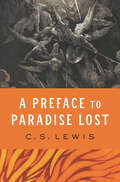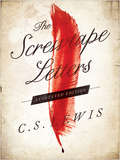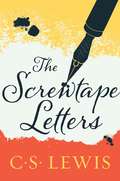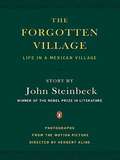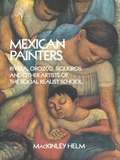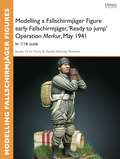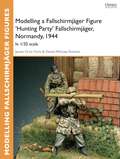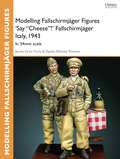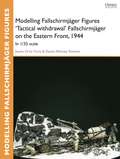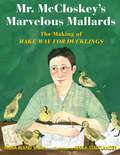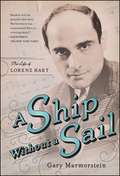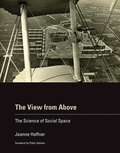- Table View
- List View
Art and Poetry
by Jacques MaritainOriginally titled Frontieres de la poesie (1935), This book by Jacques Maritain, whose philosophical writings read as interestingly as a novel, will be welcomed by all who are seeking a better understanding of the art of our time. The book delves into Maritain s thoughts on the nature and subjectivity of art and poetry. As a philosopher, Maritain attempts to define the two concepts, describing art and poetry as virtues, and as primarily concerned with beauty. Rather than focus on aesthetic theory, Maritain examines the concepts at a more tangible level, including a discussion of how they are made. The principles established with such precision and brilliance in his earlier work Art and Scholasticism, which has had such a deep influence on contemporary artists, are successfully put to the test in illuminating the creative works of such diverse artists as Rouault, Marc Chagall, Gino Sevirini, and Arthur Lourie. Jacques Maritain was a French Catholic philosopher and political thinker. He was born in Paris in 1882, where he spent most of his life. His father was a prominent lawyer and his mother the daughter of a statesman. He attended the Sorbonne to study philosophy and natural science, and after marrying, he and his wife converted to Catholicism. It was after this he became a well-known scholar of St. Thomas Aquinas and Thomistic philosophy. He published widely on philosophical and political thought, and by the 1930s, he was an established thinker in the Catholic community. After the outbreak of WWII, Maritain relocated to the United States, where he taught at Princeton University and Columbia University. Later in life, he and his wife returned to France, where he continued to write and study Catholic scholarship until his death in 1973.
The Art of the Story-Teller
by Marie L. Shedlock"It is a delight to see a new edition of this long out-of-print book, the best on the subject of stpry-telling." -- The Junior Bookshelf. Everything you need to know to tell stories successfully to children: choosing material, using gestures, capturing straying attentions, more. 18 ready-for-telling stories written especially for youngsters. Annotated bibliography of 135 stories.
The Impressionists at First Hand (World of Art #0)
by Bernard DenvirAn updated edition of this classic collection of letters, critical reviews, and reminiscences by impressionist artists and their contemporaries. The impressionists—Claude Monet, Édouard Manet, Edgar Degas, Berthe Morisot, Camille Pissarro, Pierre-Auguste Renoir, Alfred Sisley, and others—are probably the most popular of all artistic schools. Their struggle to impose a new vision is one of the most absorbing stories in the whole history of art. With imagination and insight, art historian Bernard Denvir brings impressionism into focus by showing it through the eyes of the artists themselves and their contemporaries, against the background of the time. Through letters, critical reviews, statements, and reminiscences of the people who were there, the story of this groundbreaking art movement comes alive. This was the age of innovation, political liberalization, emergent photography, and modern ideas about perception. The impressionists had new ways of painting, but they also had a new world to paint. This revised edition now features full-color reproductions of art throughout and an updated bibliography.
Modelling Fallschirmjäger Figures
by Jaume FornsThe German Fallschirmj¿ger were elite soldiers, a factor that continues to ensure their popular appeal today, particularly among modellers. There are many Fallschirmj¿ger figures on the market, in plastic, metal and resin, and in all three of the most popular scales - 1/35, 1/32 (54mm), and 1/15 or 1/16 (120mm). Manufacturers currently produce figures related to every major campaign they were involved in. This is the first book to address the subject of German paratroopers for the figure modeller. All the major items of Fallschirmj¿ger uniform and equipment are covered, with an emphasis on specially designed paratrooper items. Camouflage uniforms were prominent among these units, with several patterns employed, and these are particularly attractive to the figure painter. Clear step-by-step instructions allow the reader to recreate these patterns in miniature with confidence and ease. This book will be of interest to all figure modellers, and to AFV modellers too, with the techniques explained easily transferrable to other scales. It covers painting, superdetailing, and conversion techniques (from simple to advanced), and key aspects of scene creation and setting, such as groundwork, balance, and composition, with projects ranging from single-figure studies to full-scale dioramas. Each chapter develops the modelling techniques in a progressive manner, as well as revealing the chronological development of Fallschirmj¿ger uniforms and equipment in sequence. This highly accessible book makes use of commercially available figures, from different firms and in different materials. Jaume and Daniel's superb presentation skills are brought to the fore in this visually detailed, packed and engaging treatment of one of the most enduring figure-modelling subject areas.
The New Soviet Theatre (Routledge Revivals)
by Joseph MacleodFirst Published in 1943, The New Soviet Theatre presents Joseph Macleod’s take on the development and rapid changes in the Soviet Theatre since late 1930s. Through scattered articles and reports, books and bulletins, and his own visits to the USSR, Macleod showcases what we know as ‘Socialist Realism’. He brings themes like the shortcomings of the old theatre; the audience beyond the Caucasus; new socialist audiences; Alexey Popov of the Central Theatre of the Red Army; new writers and new plays; and popularity of Shakespeare both in the central theatres and in remoter and unexpected places. Written graphically but founded on scholarship this book will be an essential read for scholars and researchers of history of theatre, European theatre, theatre and performance studies.
The Peckham Experiment: A study of the living structure of society
by Innes H. Pearse Lucy H. CrockerFirst published in 2006. Routledge is an imprint of Taylor & Francis, an informa company.
Your Voice and How to Use it
by Cicely BerryAnxiety about how we speak prevents many of us from expressing ourselves well. In her classic handbook, Cicely Berry, Voice Director of the Royal Shakespeare Company and world-famous voice teacher, tackles the reasons for this anxiety and explains her practical exercises for relaxation and breathing, clarity of diction and vocal flexibility - everything that you need to achieve good speech.
The Book of Wood Carving
by Charles Marshall Sayers"This is an absolutely first-rate book for beginners in wood sculpture, well thought out and well executed. It is exceptional in the quality of its illustrations, and contains many original and unusual conceptions and designs." -- E. J. Tangerman.In answer to complaints from students that there was no concise, simple text on wood carving, Charles Marshall Sayers, a nationally famous teacher and craftsman, wrote this book. It is still the finest book for the beginning student in wood sculpture. In clear, straightforward language, Sayers carefully guides the reader through the fundamentals -- what tools and materials to use, how to use them. There are lessons and designs for incised carving, relief carving, and other cutting methods. Sayers discusses woods suitable for carving, stains and finishes, preliminary and advanced methods of preparing woods for finishing, even how to make a workbench.The 34 illustrated designs for over 34 projects encourage the student to build slowly and methodically a sound, practical technique while creating objects of beauty and utility. All of the projects employ only four tools (one straight parting tool, three different sizes of straight gouges). With this book you can make panels for cabinets, chests, and doors; borders; table aprons; chair and bench rails; circular mirror frame; wall bracket with shelf; bookends; rectangular mirror frame; footstools; guest-book covers; mirror frame with half-circle top; holy water font; and doors.Though The Book of Wood Carving is meant for the beginner, experienced carvers will find that Sayers' original conceptions and designs will increase their own pleasure and skill. "Stimulating both by spicy text and large photographs showing every point in processes described . . . [Illustrated with] designs of actual work by the author -- a famous teacher and craftsman -- and his students and apprentices." -- Books, New York Herald Tribune.
The C. S. Lewis Collection: Signature Classics and Other Major Works
by C. S. LewisEight of C. S. Lewis’s timeless signature classics together in one volume.<P><P> Includes:<P> * Mere Christianity<P> * The Screwtape Letters<P> * The Great Divorce<P> * The Problem of Pain<P> * Miracles<P> * A Grief Observed<P> * The Abolition of Man<P> * The Four Loves<P> * Reflections on the Psalms<P> * Surprised by Joy<P> * Letters to Malcolm
The Duchamp Dictionary
by Luke Frost Therese Vandling Thomas Girst"Girst elegantly unravels the skeins of Duchamp's thinking. . . . An essential compendium for puzzling out an essential artist." --Richard Armstrong, Director of the Solomon R. Guggenheim Museum and Foundation Among the most influential artists of the last hundred years, Marcel Duchamp holds great allure for many contemporary artists worldwide and is largely considered to be one of the founding fathers of modern art. Despite this popularity, books on Duchamp are often hyper-theoretical, rarely presenting the artist in an accessible way. This new book explores the artist's life and work through short, alphabetical dictionary entries that introduce his legacy in a clear and engaging way. From alchemy and anatomy to Warhol and windows, The Duchamp Dictionary offers a pithy and readable text that draws on in-depth scholarship and the very latest research. Thomas Girst includes close to 200 entries on the most interesting and important artworks, relationships, people, and ideas in Duchamp's life--from The Bicycle Wheel and Fountain to Walter and Louise Arensberg, Peggy Guggenheim, Katherine Dreier, and Arturo Schwarz. Delightful, newly commissioned illustrations introduce each letter of the alphabet and accompany select entries, capturing the irreverent spirit of the artist himself.
Painting Materials: A Short Encyclopedia (Dover Art Instruction)
by G. L. Stout R. J. GettensThe combined training and experience of the authors of this classic in the varied activities of painting conservation, cultural research, chemistry, physics, and paint technology ideally suited them to the task they attempted. Their book, written when they were both affiliated with the Department of Conservation at Harvard's Fogg Art Museum, is not a handbook of instruction. It is, instead, an encyclopedic collection of specialized data on every aspect of painting and painting research.The book is divided into five sections: Mediums, Adhesives, and Film Substances (amber, beeswax, casein, cellulose, nitrate, dragon's blood, egg tempera, paraffin, lacquer, gum Arabic, Strasbourg turpentine, water glass, etc.); Pigments and Inert Materials (over 100 entries from alizarin to zinnober green); Solvents, Diluents, and Detergents (acetone, ammonia, carbon tetrachloride, soap, water, etc.); Supports (academy board, dozens of different woods, esparto grass, gesso, glass, leather, plaster, silk, vellum, etc.); and Tools and Equipment.Coverage within each section is exhaustive. Thirteen pages are devoted to items related to linseed oil; eleven to the history and physical and chemical properties of pigments; two to artificial ultramarine blue; eleven to wood; and so on with hundreds of entries. Much of the information -- physical behavior, earliest known use, chemical composition, history of synthesis, refractive index, etc. -- is difficult to find elsewhere. The rest was drawn from such a wide range of fields and from such a long span of time that the book was immediately hailed as the best organized, most accessible work of its kind.That reputation hasn't changed. The author's new preface lists some recent discoveries regarding pigments and other materials and the pigment composition chart has been revised, but the text remains essentially unchanged. It is still invaluable not only for museum curators and conservators for whom it was designed, but for painters themselves and for teachers and students as well.
The Place of Glass in Building (John Gloag On Industrial Design Ser.)
by John GloagOriginally published in 1943, The Place of Glass in Building is a comprehensive and compact survey of the structural uses of glass in 20th Century architecture. It gives the facts about the physical properties, the possibilities and the limitations of the glass in common use. It also deals with the attributes of specialised and decorative glass and provides detailed descriptions of the principal types which were manufactured in the UK. Intended for architectural students it may also be of interest to architects, for it is a condensed survey of the progress that has been made in this structural and decorative material.
A Preface to Paradise Lost
by C. S. LewisC. S. Lewis’s illuminating reflections on Milton’s Paradise Lost, the seminal classic that profoundly influenced Christian thought as well as Lewis’s own.In Preface to Paradise Lost, the Christian apologist and revered scholar and professor of literature closely examines the style, content, structure, and themes of Milton’s masterpiece, a retelling of the biblical story of the Fall of Humankind, Satan’s temptation, and the expulsion of Adam and Eve from the Garden of Eden. Considering the story within the context of the Western literary tradition, Lewis offers invaluable insights into Paradise Lost and the nature of literature itself, unveiling the poem’s beauty and its wisdom.Lewis explains and defends the literary form known as “Epic,” pondering simple yet perceptive questions such as: What is an Epic? Why, in the seventeenth century, did Milton choose to write his story in this style? In what sense is Paradise Lost similar to the Homeric poems or the Anglo Saxon Beowulf? In what sense did Milton develop Virgil’s legacy? With the clarity of thought and style that are the hallmarks of his writing, Lewis provides answers with a lucidity and lightness that deepens our understanding of this literary form and both illuminates Milton’s immortal epic and its meaning and inspires readers to revisit it. Ultimately, he reminds us why elements including ritual, splendor, and joy deserve to exist and hold a sacred place in human life. One of Lewis’s most revered scholarly works, Preface to Paradise Lost is indispensable for literature, philosophy, and religion scholars and for ardent fans of Lewis’s writings.
The Screwtape Letters: Annotated Edition
by C. S. LewisA masterpiece of satire, this classic has entertained and enlightened readers the world over with its sly and ironic portrayal of human life from the vantage point of Screwtape, a senior tempter in the service of "Our Father Below." At once wildly comic, deadly serious, and strikingly original, C. S. Lewis gives us the correspondence of the worldly-wise old devil to his nephew Wormwood, a novice demon in charge of securing the damnation of an ordinary young man. The Screwtape Letters is the most engaging and humorous account of temptation--and triumph over it--ever written.Now, for the first time, The Screwtape Letters is presented with its full text alongside helpful annotations provided by Lewis enthusiast and dramatist Paul McCusker. The notes include literary, theological, and biographical information to enhance Lewis's core themes and demystify complex ideas. McCusker also guides readers to concepts and references from the beloved author's other treasured volumes to deepen and enrich this timeless classic. The annotated edition is the ultimate guide for understanding the heavenly truths buried in these epistles from below.
The Screwtape Letters: Letters From A Senior To A Junior Devil
by C. S. LewisIn this humorous and perceptive exchange between two devils, C. S. Lewis delves into moral questions about good vs. evil, temptation, repentance, and grace. Through this wonderful tale, the reader emerges with a better understanding of what it means to live a faithful life.
Screwtape Letters: Annotated Edition
by C. S. LewisOn the occasion of the 50th anniversary of C. S. Lewis’s death, a special annotated edition of his Christian classic, The Screwtape Letters, with notes and excerpts from his other works that help illuminate this diabolical masterpiece. Since its publication in 1942, The Screwtape Letters has sold millions of copies worldwide and is recognized as a milestone in the history of popular theology. A masterpiece of satire, it offers a sly and ironic portrayal of human life and foibles from the vantage point of Screwtape, a highly placed assistant to “Our Father Below.” At once wildly comic, deadly serious, and strikingly original, The Screwtape Letters comprises the correspondence of the worldly-wise devil Screwtape and his nephew Wormwood, a novice demon in charge of securing the damnation of an ordinary young man. For the first time, The Screwtape Letters will be presented in full-text accompanied by helpful annotations in a striking two-color format. These annotations will give fans a deeper, more nuanced understanding of the popular book, providing background information, explanations of terms, historical significance, and excerpts from Lewis’s other works that more fully explain the ideas in this volume. For both expert Lewis fans and casual readers, The Screwtape Letters: Annotated Edition will be a beautiful and insightful guide to a beloved classic.
The Forgotten Village: Life in a Mexican Village
by John Steinbeck Alexander Hackensmid Rosa Harvan KlineThe novelist who wrote The Grapes of Wrath and the director who produced Crisis and Lights Out in Europe combined their superb talents to tell the story of the coming of modern medicine to the natives of Mexico. There have been several notable examples of this pen-camera method of narration, but The Forgotten Village is unique among them in that the text was written before a single picture was shot. The book and the movie from which it was made have, thus, a continuity and a dramatic growth not to be found in the so-called "documentary" films. The camera crew that, headed by Kline and with Steinbeck's script at hand, recorded this narrative of birth and death, of witch doctors and vaccines, of the old Mexico and the new, spent nine months off the trails of Mexico. They traveled thousands of miles to find just the village they needed; they borrowed children from the government school, took men from the fields, their wives from the markets, and old medicine woman from her hut by the side of the trail. The motion picture they made (for release in 1941) is 8000 feet long. From this wealth of pictures 136 photographs were selected for their intrinsic beauty and for the graceful harmony with which they accompany Steinbeck's text. This new script-photograph technique of narration conveys its ideas with unexcelled brilliance and immediacy. In the hands of such master story-tellers as Steinbeck and Kline, it makes the reader catch his breath for the beauty and the truth of the tale.
Mexican Painters: Rivera, Orozco, Siqueiros, and Other Artists of the Social Realist School
by Mackinley HelmFrom the monumental public frescoes of Diego Rivera, José Clemente Orozco, and David Álfaro Siqueiros, to the canvasses and drawings of younger artists like Galván, Cantú, Meza, Tamayo, and Orozco Romero, Mexican painting since the First World War has developed into a strong, influential artistic tradition.This book explores this Mexican tradition -- the artists, their works, the social and political background, and the relationship of the modern painters to European and Mexican historical tradition. Helm, an important collector who knew most of the artists, writes informally yet with deep understanding about the major figures -- Orozco, Rivera, and Siqueiros -- as well as over 40 others little known outside their native Mexico.He ably ties together such diverse influences as the Revolution and the regime of Obregón, the Siqueiros Syndicate and its power in getting artists to pool resources and works for a powerful national style, Rivera's strong political beliefs and their effect on his work, Orozco's deep empathy, the development of the young artists, the effects of low wages and bohemian existence on artistic production, links to Indian art, the rediscovery of fresco technique, important patrons, the religious and anti-religious forces in the early works, and much more. In addition, 95 works by 37 artists are reproduced, showing the range and best works of modern Mexican painting.MacKinley Helm was in a uniquely favorable position to write about these artists, and his book is now considered the best introduction to the art and artists of Mexico during the great artistic movements of the '20s and '30s. Collectors, artists, and others who have felt the lack of solid information about this important Western tradition will find this book gives clear insight into the conflicts, personalities, and important works that have developed into modern Mexican art.
Modelling a Fallschirmjäger Figure early Fallschirmjäger, 'Ready to jump' Operation Merkur, May 1941
by Jaume FornsThis is one of four guides addressing the subject of modelling a German Fallschirmjäger figure model. The major items of Fallschirmjäger uniform and equipment are covered, with an emphasis on specially designed paratrooper items. Clear step-by-step instructions allow the reader to recreate realistic figures in miniture scale with confidence and ease. Among the tutorials covered in this guide are face painting, creating complex camouflage patterns, weathering clothing, and figure conversion techniques, as well as vignette and diorama settings for your figures (creating groundwork and balancing composition). This title provides a detailed, step-by-step guide to modelling an early Fallschirmjäger, Operation Merkur, May 1941. It also provides a comprehensive list of available aftermarket products and kits of all scales. This guide forms part of Osprey Modelling 31 Modelling Fallschirmjäger Figures ebook.
Modelling a Fallschirmjäger Figure 'Hunting Party' Fallschirmjäger, Normandy, 1944
by Jaume FornsThis is one of four guides addressing the subject of modelling a German Fallschirmjäger figure model. The major items of Fallschirmjäger uniform and equipment are covered, with an emphasis on specially designed paratrooper items. Clear step-by-step instructions allow the reader to recreate realistic figures in miniture scale with confidence and ease. Among the tutorials covered in this guide are face painting, creating complex camouflage patterns, weathering clothing, and figure conversion techniques, as well as vignette and diorama settings for your figures (creating groundwork and balancing composition). This title provides a detailed, step-by-step guide to modelling a Fallschirmjäger, Normandy, 1944. It also provides a comprehensive list of available aftermarket products and kits of all scales. This guide forms part of Osprey Modelling 31 Modelling Fallschirmjäger Figures ebook.
Modelling Fallschirmjäger Figures 'Say "Cheese"!' Fallschirmjäger Italy, 1943
by Jaume FornsThis is one of four guides addressing the subject of modelling a German Fallschirmjäger figure model. The major items of Fallschirmjäger uniform and equipment are covered, with an emphasis on specially designed paratrooper items. Clear step-by-step instructions allow the reader to recreate realistic figures in miniture scale with confidence and ease. Among the tutorials covered in this guide are face painting, creating complex camouflage patterns, weathering clothing, and figure conversion techniques, as well as vignette and diorama settings for your figures (creating groundwork and balancing composition). This title provides a detailed, step-by-step guide to modelling a Fallschirmjäger in Italy, 1943. It also provides a comprehensive list of available aftermarket products and kits of all scales. This guide forms part of Osprey Modelling 31 Modelling Fallschirmjäger Figures ebook.
Modelling Fallschirmjäger Figures 'Tactical withdrawl' Fallschirmjäger on the Eastern Front, 1944
by Jaume FornsThis is one of four guides addressing the subject of modelling a German Fallschirmjäger figure model. The major items of Fallschirmjäger uniform and equipment are covered, with an emphasis on specially designed paratrooper items. Clear step-by-step instructions allow the reader to recreate realistic figures in miniture scale with confidence and ease. Among the tutorials covered in this guide are face painting, creating complex camouflage patterns, weathering clothing, and figure conversion techniques, as well as vignette and diorama settings for your figures (creating groundwork and balancing composition). This title provides a detailed, step-by-step guide to modelling a Fallschirmjäger on the Eastern Front, 1944. It also provides a comprehensive list of available aftermarket products and kits of all scales. This guide forms part of Osprey Modelling 31 Modelling Fallschirmjäger Figures ebook.
Mr. McCloskey's Marvelous Mallards: The Making of Make Way for Ducklings
by Emma Bland SmithThis behind-the-scenes look at the creation of the classic and beloved picture book Make Way for Ducklings will captivate young artists, writers, readers, and animal lovers alike.While writing and illustrating the beloved picture book Make Way for Ducklings, Robert McCloskey brings a flock of ducklings into his tiny New York City apartment. But an artist + a bunch of ducklings in his apartment = chaos! There are ducklings in the bathtub and ducklings in the kitchen, quacking at dawn and sitting on his desk. Can he learn to draw them just right before they grow too big? This glimpse into the creation of a much-loved story for kids is a must-read for fans of children&’s books, or for anyone who is interested in the creative process and the importance of persistence. &“Emma Smith has done a bang-up job imagining how my father wrote Make Way for Ducklings. I enjoyed reading her book.&” —Jane McCloskey, daughter of Robert McCloskey and author ofRobert McCloskey: A Private Life in Words and Pictures&“A wonderfully rollicking rendition of the story behind the story.&” —Gary D. Schmidt, Newbery Honor-winning author of books for children and author of Robert McCloskey
A Ship Without A Sail: The Life of Lorenz Hart
by Gary MarmorsteinAn unforgettable portrait of an exuberant yet troubled artist who so enriched the American songbook "Blue Moon, " "Where or When, " "The Lady Is a Tramp," "My Funny Valentine," "Isn't It Romantic?," "My Romance," "There's a Small Hotel," "Falling in Love with Love," "Bewitched, Bothered and Bewildered"--lyricist Lorenz Hart, together with composer Richard Rodgers, wrote some of the most memorable songs ever created. More than half a century after their collaboration ended, Rodgers & Hart songs are indispensable to the repertoire of nightclub singers everywhere. A Ship Without a Sail is the story of the complicated man who was Lorenz Hart. His lyrics spin with brilliance and sophistication, yet at their core is an unmistakable wistfulness. The sweetness of "My Romance" and "Isn't It Romantic?" is unsurpassed in American song, but Hart's lyrics could also be cynical, funny, ironic. He brought a unique wit and elegance to popular music. Larry Hart and Richard Rodgers wrote approximately thirty Broadway musicals and dozens of songs for Hollywood films. At least four of their musicals--On Your Toes, Babes in Arms, The Boys from Syracuse, and Pal Joey-- have become classics. But despite their prodigious collaboration, Rodgers and Hart were an odd couple. Rodgers was precise, punctual, heterosexual, handsome, and eager to be accepted by Society. Hart was barely five feet tall, alcoholic, homosexual, and more comfortable in a bar or restaurant than anywhere else. Terrified of solitude, he invariably threw the party and picked up the check. His lyrics are all the more remarkable considering that he never sustained a romantic relationship, living his entire life with his mother, who died only months before he died at age forty-eight. Gary Marmorstein's revelatory biography includes many of the lyrics that define Hart's legacy--those clever, touching stanzas that still move us or make us laugh.
The View from Above
by Jeanne Haffner Peter GalisonIn mid-twentieth century France, the term "social space" ( l'espace social) -- the idea that spatial form and social life are inextricably linked -- emerged in a variety of social science disciplines. Taken up by the French New Left, it also came to inform the practice of urban planning. In The View from Above, Jeanne Haffner traces the evolution of the science of social space from the interwar period to the 1970s, illuminating in particular the role of aerial photography in this new way of conceptualizing socio-spatial relations. As early as the 1930s, the view from above served for Marcel Griaule and other anthropologists as a means of connecting the social and the spatial. Just a few decades later, the Marxist urban sociologist Henri Lefebvre called the perspective enabled by aerial photography -- a technique closely associated with the French colonial state and military -- "the space of state control." Lefebvre and others nevertheless used the notion of social space to recast the problem of massive modernist housing projects (grands ensembles) to encompass the modern suburb (banlieue) itself -- a critique that has contemporary resonance in light of the banlieue riots of 2005 and 2007. Haffner shows how such "views" permitted new ways of conceptualizing the old problem of housing to emerge. She also points to broader issues, including the influence of the colonies on the metropole, the application of sociological expertise to the study of the built environment, and the development of a spatially oriented critique of capitalism.
